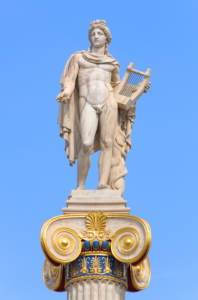LGBT Love in Greek Mythology

For as far back as recorded history goes, human beings have crafted stories. Many of these tales began as oral traditions. They were passed down from generation to generation until the invention of writing. Spinning these proverbial yarns offered a way for people to make sense of the world around them and the connections that they shared with others. Love in all of its forms has always been an important theme in many older myths. In fact, there are some interesting and moving stories of LGBT love in Greek mythology that can be found by looking backwards in time.
The Wind and the Flowers
Greek mythology has something of a reputation for LGBT stories. The gods and goddesses chose their consorts without regard for gender, and this led to some bizarre and fascinating stories. While the words of love and adoration were strong in many stories, there was an equal amount of attention paid to less positive emotions like jealousy. One of the more interesting myths tells the story of Hyacinthos. Sometimes referred to simply as Hyacinth, he was a beautiful youth from Sparta with a knack for throwing a discus.
Due to his beautiful looks and talents, Hyacinthos was noticed by the sun god, Apollo. The two became lovers and spent their time together playing discus in the dazzling beauty of the sun’s rays. Unfortunately, Apollo was not the only god to take notice of the talents and beauty of Hyacinthos. Zephyros, god of the west wind, was also captivated by the young Spartan. He found himself growing more and more jealous of the bond the young man shared with Apollo. During one of their normal discus games, Zephyros used his control of the winds to send the discus straight at Hyacinthos.
The discus killed Hyacinthos instantly, emotionally crushing Apollo. Knowing that Hyacinthos was bound for Hades and the Underworld, Apollo decided to take action. He gathered some of the blood that had fallen to the ground when Zephyros caused Hyacinthos to be struck by the discus. Apollo used this blood to create a flower that would carry on the memory of the young man. As Apollo held the flower, tears that fell from his eyes hit the petals and gave the flower its unique look. While not the same hyacinth flower known today, this is an ancient tale that showcases intense love.
Reading Between the Lines
Mythology is particularly interesting because a great deal of it is left up to interpretation. As stories are passed down from generation to generation, they begin to take on a life of their own. This means that it is difficult to pinpoint which version of these stories is, in fact, the truth. Since most of mythology is built on fiction anyway, it stands to reason that all versions of a story are widely acceptable. One such story is about Agamemnon, famed hero of the Trojan War.
Most accounts tell that Agamemnon was married to a woman, Clytemnestra. The story goes that an affair she had led to the eventual death of Agamemnon. What many stories gloss over, however, is that Agamemnon had an intense love affair of his own with fellow warrior Argynnus. Though it’s not included in all stories of Agamemnon, enough writers included this detail to make it a part of Agamemnon’ tale.
The story of Agamemnon and Argynnus is brief. The two were old friends and comrades, falling deeply in love throughout their time together. Unfortunately, Argynnus drowned while attempting to cross a river. Devastated, Agamemnon buried him and mourned for quite a bit of time. The part of the story dealing with Agamemnon’s grief is the most recorded part of the tale.
History Unfolds
Looking back at historical myths helps to shed some light on the rich and interesting story of the human race. There are many interesting LGBT love stories to be found throughout different cultures at different points in time, including Greek mythology. Find a story that interests you and learn more about it all.














